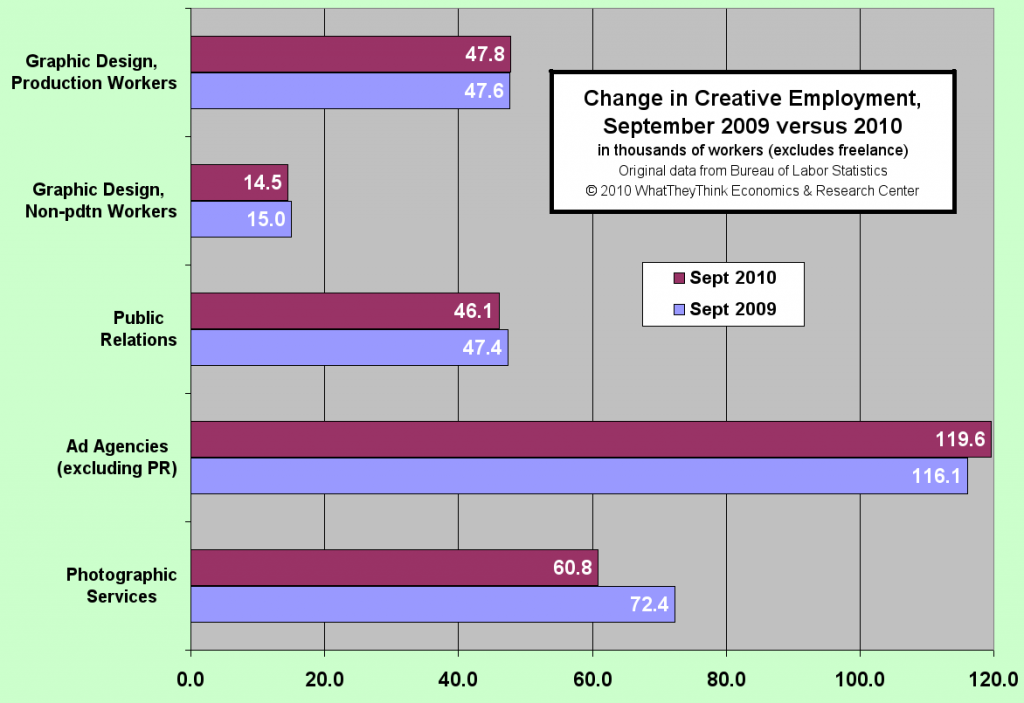Commentary & Analysis
Does Creative Employment Indicate Good News for Print Volume?
One of the indicators for future print demand has been changes in employment levels in ad agencies,
One of the indicators for future print demand has been changes in employment levels in ad agencies, graphic design businesses, and others. Over the years, these have become less indicative of such because of the shift in media, and the likely long term erosion of paid advertising media, such as magazines. Also, the non-paid advertising media of e-mail campaigns, web sites, social media such as Twitter and Facebook, search engine optimization, and others, have shifted the nature of agency employment to include more production personnel for these formats. Nonetheless, changes in employment compared to last year imply at least a better communications market to which printers can offer their services.
The chart below shows the changes compared to last year, in thousands of workers.
One factor that cannot be accounted for with these data are freelance employment. Yet that may be a good sign as well. Recessions tend to create "unintended entrepreneurs" in the creative services business, and increases in payroll employment there is usually encouraging.
Graphic design production workers are up +0.4%, adding 200 workers since last year. That may not seem like a lot, but it has stopped declining, and has increased while non-production workers, generally supervisory and administrative workers, has gone down. Public relations workers has decreased by 1,300 workers, or -2.7%. There is a vibrant and entrenched freelance or sole practitioner community in this market which may not be indicated here. In the last decade, PR employment has been gaining share in total advertising employment, and this trend may now be flattening or complete. Employment in ad agencies, excluding PR, is up by 3,500 workers, or +3%. Ad budgets are coming back, and some of it may be related to the increased expenditures by automakers. Sadly, photographic services, such as commercial photographers, have been taking it on the chin, and this is mainly a technology issue. Digital photography has changed this market greatly.
Overall, none of these categories are near their December 2007 levels, the date which the recession started. Agency employment, excluding PR, is down by 24,300 workers. PR employment is down by 2,700 workers. Graphic design production workers are down by 13,000 workers, while non-production employment is flat. Compared to last year, it seems that we have bottomed out in creative employment, but there still is quite a bit to recover. Many of those "unintended entrepreneurs" in the freelance business are likely to remain free agents for some time.
For that reason, print businesses may find these pros to be good resources as they cultivate their marketing services (much as I dislike the term) and digital media services businesses. Because full time employment is not likely to pick up in the traditional markets for these workers, now is a good time to be auditioning new talent at low risk for the transformed print enterprise.
About Dr. Joe Webb
Dr. Joe Webb is one of the graphic arts industry's best-known consultants, forecasters, and commentators. He is the director of WhatTheyThink's Economics and Research Center.
Video Center
- Questions to ask about inkjet for corrugated packaging
- Can Chinese OEMs challenge Western manufacturers?
- The #1 Question When Selling Inkjet
- Integrator perspective on Konica Minolta printheads
- Surfing the Waves of Inkjet
- Kyocera Nixka talks inkjet integration trends
- B2B Customer Tours
- Keeping Inkjet Tickled Pink
© 2024 WhatTheyThink. All Rights Reserved.















